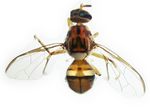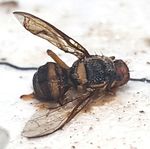PEST ALERT Florida Department of Agriculture and Consumer Services Division of Plant Industry - Florida Department of ...
←
→
Page content transcription
If your browser does not render page correctly, please read the page content below
PEST ALERT
FDACS-P-01884
Created November 2002
Updated June 2018
Florida Department of Agriculture and Consumer Services
Division of Plant Industry
Bactrocera dorsalis, Oriental fruit fly (Hendel) (Tephritidae)
Dr. Gary J. Steck, Bureau of Entomology, Nematology and Plant Pathology
DPIHelpline@FreshFromFlorida.com or 1-888-397-1517
INTRODUCTION: A single male of the Oriental fruit fly, Bactrocera dorsalis (Hendel) (Tephritidae), was captured in a methyl
eugenol-baited fruit fly detection trap in Miami (Miami-Dade Co.) on 1 June 2018. Two additional males were captured in
nearby detection traps on 3 June 2018. Oriental fruit fly is one of several members of a complex of closely related species
that are of great economic importance, and the Florida and U.S. Departments of Agriculture respond aggressively to the
detection of any of these fruit flies in the State. In the case of detection of any pest fruit fly, the response is an intensified and
expanded trapping survey to determine whether or not other flies are present in the area. Usually, only a single fly is detected
and no control measures are needed. Single Oriental fruit flies have been found in Florida on numerous earlier occasions,
most recently in January 2017 in Mt. Dora, June 2017 in Clearwater, and July 2017 in Weston. On rare occasions, such as
August of 2015 in Miami-Dade Co., a major outbreak of Oriental fruit fly may occur requiring an eradication program.
TAXONOMY: The Bactrocera dorsalis complex of fruit flies, in the broad sense, comprises at least 68 species with varying
distributions in Asia, Australia and the Pacific islands. Most of these species can be identified with confidence. Bactrocera
dorsalis s.s.,however, has a complicated taxonomic history. In 1994, several species were newly described as part of a
cryptic species complex: Bactrocera papayae Drew & Hancock, Bactrocera philippinensis Drew & Hancock, and Bactrocera
carambolae Drew & Hancock. In 2005, Bactrocera invadens Drew, Tsuruta & White, was added to the mix. Intensive re-
examination of this complex in recent years has led to the synonymization of several of these species. As a result, only B.
dorsalis and B. carambolae are now recognized as distinct and valid species (Schutze et al. 2014).
DISTRIBUTION: Bactrocera dorsalis occurs in a broad swath from Pakistan and India east to southern China, Taiwan, and
southeast Asia, including Malaysia and the great island groups of Sumatra, Java, Borneo and the Philippines. It has been
introduced and established in some Pacific islands, such as the Hawaiian Islands since about 1945, and Guam since 1947.
It invaded east Africa in about 2003 and spread very rapidly throughout large parts of the continent. Bactrocera dorsalis is a
frequent invader into California where numerous eradication programs have been conducted.
The native distribution of Bactrocera carambolae overlaps extensively with that of B. dorsalis, in much of the southern part
of its range, and it was introduced into Suriname about 1975 where it has become established.
HOST PLANTS: These flies infest a broad range of host plants including fruits and vegetables wherever they occur. The
exact host range varies by area of infestation. Many specific host records are uncertain because of misidentification of the
fruit fly species involved. This pest has been recorded from over 430 different hosts.
ADULT IDENTIFICATION: The thorax typically is mostly dark with two prominent, yellow stripes dorsally, a yellow scutellum,
and yellow areas laterally; the abdomen has a prominent, ‘T’-shaped, black pattern on a rusty brown background, plus
variable other dark markings laterally. The wings are clear, except for a thin, continuous brown band extending from the
stigma to the wing tip, and a thin, oblique, band of brown overlapping the posterior cubital cell. The face has a conspicuous
black spot below each antenna.ATTRACTANT: Males, but usually not females, are attracted to methyl eugenol, a naturally occurring plant compound. Detection of this and many other fruit flies depends on a widespread grid of baited traps in areas where introductions are likely to occur. Once a fly is detected, the trapping density is greatly increased for several square miles around the detection point. If further flies are detected, an eradication program may be implemented. As methyl eugenol is such a powerful attractant, an insecticide can be added to the bait to remove the males from the population, which can then no longer maintain itself. This is known as the male annihilation technique. REFERENCES: Drew, R.A.I. 1989. The tropical fruit flies (Diptera: Tephritidae: Dacinae) of the Australasian and Oceanian Regions. Memoirs of the Queensland Museum 26: 1-521. Drew, R.A.I. and D.L. Hancock. 1994. The Bactrocera dorsalis complex of fruit flies (Diptera: Tephritidae: Dacinae) in Asia. Bulletin of Entomological Research Supplement Series, Supplement No. 2, 68 p. Drew, R.A.I., K. Tsuruta, and I.M. White. 2005. A new species of pest fruit fly (Diptera: Tephritidae: Dacinae) from Sri Lanka and Africa. African Entomology 13: 149-154. Schutze, Mark, et al. 2014. Synonymization of key pest species within the Bactrocera dorsalis species complex (Diptera:Tephritidae): taxonomic changes based on a review of 20 years of integrative morphological, molecular, cytogenetic, behavioral and chemoecological data. Systematic Entomology 40: 456-471. White, I. M. and M. M. Elson-Harris. 1992. Fruit flies of economic significance: their identification and bionomics. CAB International, Wallingford, Oxon, UK and The Australian Center for Agricultural Research, Canberra, Australia. 601 p. White, I. M. & D. L. Hancock. 1997. Indo-Australasian Dacini fruit flies. (Computer Aided Biological Identification Key). International Institute of Entomology, London. Compact Disk. Bactrocera dorsalis, Oriental fruit fly, male, dorsal view. Bactrocera dorsalis, Oriental fruit fly, male, dorsal view. Photo credit: Gary Steck, FDACS/DPI Photo credit: Gary Steck, FDACS/DPI Bactrocera dorsalis, Oriental fruit fly, female, lateral view. Bactrocera dorsalis, Oriental fruit fly, male, lateral view. Photo credit: Gary Steck, FDACS/DPI Photo credit: Gary Steck, FDACS/DPI
Oriental fruit fly captured Miami, 1 June 2018. Photo credit: Vilmaliz Rodriguez-Guzman, USDA Plant Health Safeguarding Specialist
You can also read























































